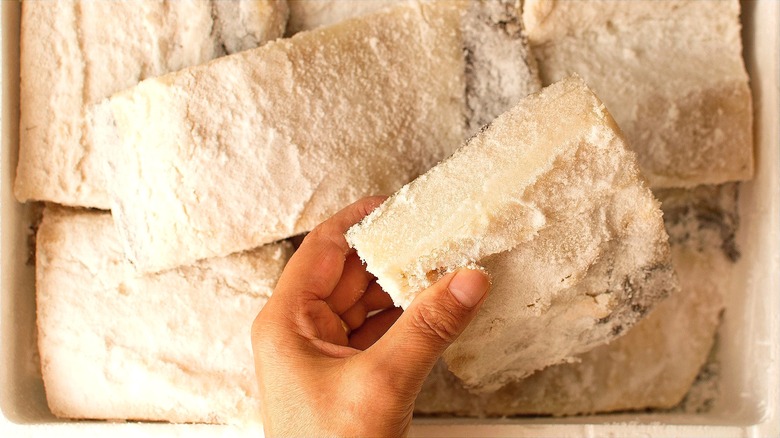How To Debone Saltfish Like A Pro
Saltfish, also known as bacalao or salted codfish, is a multicultural Caribbean delight that can be purchased with or without bones. While this vacuum-sealed fish comes pre-seasoned for extensive preservation, you need a reliable way to remove any included bones before consuming. Among the mistakes you want to avoid when cooking fish, forgetting to remove those tiny translucent bones may have unforeseen consequences. Luckily, deboning saltfish doesn't have to be complicated and can be completed before or after cooking. Though, if an intended recipe calls for whole fillets, deboning your saltfish before cooking is recommended.
To successfully remove the bones, first rinse the fish under running water; then soak it for up to 24 hours in cold water in your refrigerator, changing out the water at intervals. Soaking not only rehydrates your fish but also removes excess salt. Once soaked, use a sharp knife to remove the bones. Pin bones or smaller thread-like bones can be identified by pressing down on each individual fillet and then removing the bones one by one as they pop through the surface of the flesh. Use pliers or tweezers to streamline the process. Once all the bones have been removed, you're ready to cook whole salted fillets in a variety of braised, roasted, and pan-fried recipes.
Another way to successfully debone saltfish
If you don't need to maintain the structure of your salted codfish, boiling the fillets first and then removing the bones may be an easier process. Before cooking, either soak the fish in cold water in your refrigerator for at least 12 hours or submerge and rinse your pieces back-to-back more than once. Then, add the fish to a pot of boiling water and cook for up to 10 minutes.
Keep in mind that cooking times may differ based on the size and thickness of each fillet. Begin to check the texture of your fish after five minutes of boiling time. Since we're dealing with a cured fish, and thus one partially "cooked" through the salting process, boiling is mainly for rehydrating the fish and fine-tuning the texture. This requires less cooking time than raw, unsalted fillets. If you plan to use fully-cooked saltfish in recipes that require additional heat, keep a close watch on your pot to avoid over-boiling.
Once done, submerge the fillets in a bowl of cold water and gently break apart each portion with your hands, carefully removing the bones as you work. When all the bones have been removed, rinse your shredded fish in cold water one last time before using. Use freshly deboned saltfish to make fish cakes, stew, and protein-rich salads. You can also take a break from your favorite shrimp and eggplant stir-fry and instead, add shredded saltfish to a simmering pan of hot peppers, diced tomatoes, and green onions.

